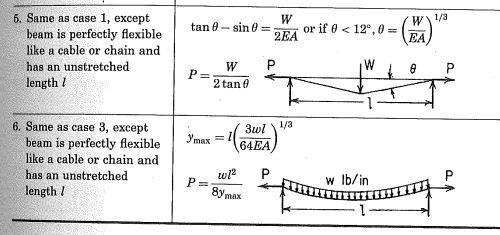adharma0
Structural
- May 29, 2015
- 2
Hello guys...I am trying to find the correct equation to calculate horizontal reaction (H) in the cable due to its self weight (w) and also a concentrated load (P) that is applied horizontally.
The cable is spanned horizontally and the span length is 50 feet (fixed both ends) and the diameter of the cable is, say 0.177 inch (w= 0.084 lb/ft). I would like to limit the maximum vertical deflection (vertical sag due to self weight of the cable) to, say 3 inches at mid-span. Also, there is a concentrated load that is being applied "horizontally" on the cable: P (horizontal) = 200 lb. I would like to limit the "horizontal deflection" to be no more than 1 inch at the location of the applied concentrated "horizontal" load (P). What is the correct formula that I should use to calculate the horizontal force "H" at each end of the cable knowing that I have a horizontal concentrated load (P) and a uniform self-weight (w) of a cable? I do not have any specific steel cable in mind; therefore, I am open to suggestion regarding what kind of steel cable I should use in order to make sure that the horizontal reaction at the end of the cable (H) is lees than the breaking strength of the cable. Please tell me the material properties of the steel cable if you have any suggestion.
Thank you.
The cable is spanned horizontally and the span length is 50 feet (fixed both ends) and the diameter of the cable is, say 0.177 inch (w= 0.084 lb/ft). I would like to limit the maximum vertical deflection (vertical sag due to self weight of the cable) to, say 3 inches at mid-span. Also, there is a concentrated load that is being applied "horizontally" on the cable: P (horizontal) = 200 lb. I would like to limit the "horizontal deflection" to be no more than 1 inch at the location of the applied concentrated "horizontal" load (P). What is the correct formula that I should use to calculate the horizontal force "H" at each end of the cable knowing that I have a horizontal concentrated load (P) and a uniform self-weight (w) of a cable? I do not have any specific steel cable in mind; therefore, I am open to suggestion regarding what kind of steel cable I should use in order to make sure that the horizontal reaction at the end of the cable (H) is lees than the breaking strength of the cable. Please tell me the material properties of the steel cable if you have any suggestion.
Thank you.

